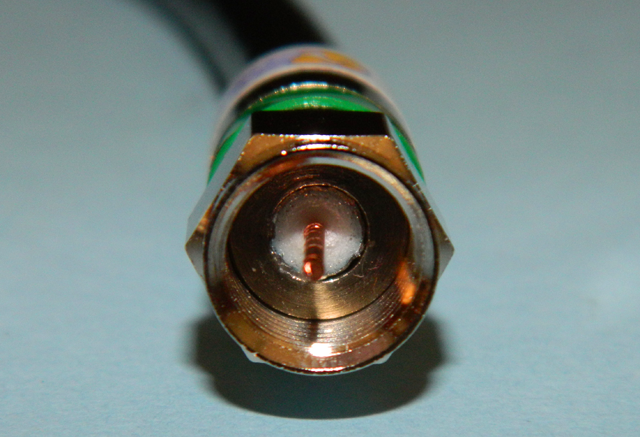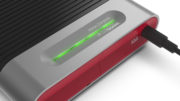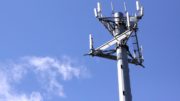Take a look around you at your home theater installation. Most of the cable you’ll see is RG6 cable, and that’s 75 Ohm impedance. In almost every case, the cable type is printed on the side of the cable.
While you’re probably swimming in RG6 cables — I know I am — you might be surprised to find that there are a few other cables in your home or office that aren’t RG6. They may be labeled as RG8, LMR400, or just have no label at all. Those are 50-ohm cables, and no matter what kind of end you put on them they won’t work well for cable, satellite or antenna use.
How are 50-ohm cables different from 75-ohm cables?
The terms “50-ohm” and “75-ohm” are descriptions of the impedance of the cable. The concept of impedance is fairly complex, so we won’t focus on that for now. All you need to know is that if you see an average cable with an F-style connnector (like the one at the top of the photo,) that’s 75 Ohm cable. There’s no law against using that kind of connector on a cable with different impedance, but the industry has standardized around using certain connectors with certain impedance cables. This is partially because it makes it easy to identify cables by sight that way, and partially because different connectors are good for different kinds of signals, just like different cable types are good for different kinds of signals.
What does this matter in the real world?
If you follow the world of cellular boosters, you’ll notice that professional cellular boosters have always used 50 Ohm cables with N connectors, while residential ones have often used 75 Ohm cable with F connectors.
Using the wrong impedance cable leads to higher-than expected losses. This generally means that the device you attached the cable to won’t work. You should always use the right cable in permanent installations.
So which is best?
50 Ohm cable is best for the longer runs that usually happen in commercial installation. While some 50 Ohm cable has loss characteristics similar to 75 Ohm cable, LMR400 and other 50 Ohm cables have much less loss over long distances. They can take the same strong signal as 75 Ohm cable, but perform better. Signals that run on low-loss cable can travel further without an amplifier. This explains why you will find 50 Ohm cable in commercial cellular signal boosters installations where the runs tend to be longer.
In the past, some residential cell boosters also used 50 Ohm cable. Today all of them use 75 Ohm cable. There’s nothing wrong with using 50 Ohm cable for residential boosters, but consumers are very comfortable with 75 Ohm cable and may be able to avoid running new cable if there is some in place. That’s why you will find all the top booster products running on 75 Ohm cable.
Choose the right cable for your installation
If you’re installing your own cellular signal booster and need cable, you’ll find the best selection at Solid Signal. We have thousands of pre-made 50 Ohm and 75 Ohm cables and can also help you with custom designs if you need. If you don’t find what you’re looking for at our site, call our technicians at 888-233-7563 to get personalized, free tech support.





